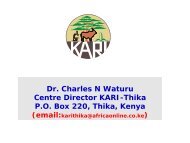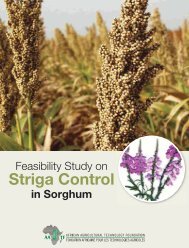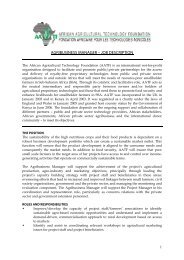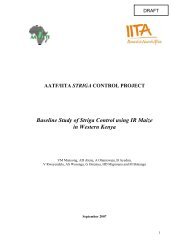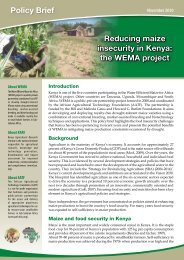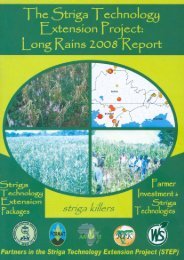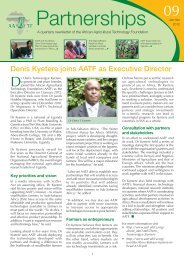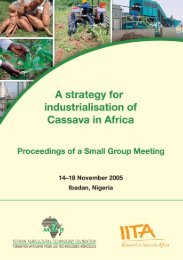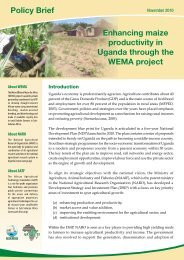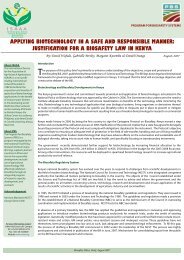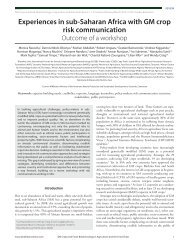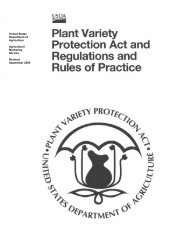Partnerships Issue 10 - African Agricultural Technology Foundation
Partnerships Issue 10 - African Agricultural Technology Foundation
Partnerships Issue 10 - African Agricultural Technology Foundation
You also want an ePaper? Increase the reach of your titles
YUMPU automatically turns print PDFs into web optimized ePapers that Google loves.
Project updates (continued)<br />
Progress and planning meeting held for Bacterial Wilt Resistant Banana project<br />
Partners working on the Bacterial<br />
Wilt Resistant Banana project met<br />
in July 2012 in Kampala to review<br />
progress made and also plan for 2012<br />
and 2013 activities. The project, which<br />
is a partnership between AATF, National<br />
<strong>Agricultural</strong> Research Organisation of<br />
Uganda and the International Institute<br />
of Tropical Agriculture is developing<br />
banana varieties that are resistant to the<br />
banana bacterial wilt disease from East<br />
<strong>African</strong> farmer preferred germplasm.<br />
During the meeting, scientists working<br />
on the project reported that their<br />
endeavors have generated several lines<br />
of the apple banana popularly known as<br />
sukali ndizi that have shown resistance to<br />
the disease after being inserted with two<br />
genes extracted from sweet pepper. The<br />
genes have been donated royalty-free for<br />
use in the project by Academia Sinica,<br />
Taiwan through negotiations by AATF.<br />
The Banana meeting participants during a field trip to the Project’s confined field trial<br />
site in Kawanda, Uganda in July 2012.<br />
The lines are undergoing testing under<br />
confined field trials at the Kawanda<br />
research station in Uganda. The meeting<br />
was also attended by participants drawn<br />
from various research institutes involved<br />
in banana research in Kenya, Tanzania,<br />
Rwanda, Burundi and Uganda n<br />
For more information contact Jacob<br />
Mignouna (h.mignouna@aatf-africa.org)<br />
Striga control in maize<br />
project holds partners<br />
meeting and farmer field<br />
days<br />
In an effort to enhance the uptake<br />
and awareness of the use of the<br />
StrigAway Imazapyr Resistant (IR)<br />
maize technology in the control of<br />
the Striga weed, the Striga Control in<br />
Maize project conducted farmer field<br />
days in Kenya in July, and in Uganda and<br />
Tanzania in August 2012 and also held<br />
a strategic partners meeting in Nairobi.<br />
The partners meeting, attended by<br />
representatives from Kenya, Uganda<br />
and Tanzania including seed companies<br />
reviewed the status of the project since its<br />
launch in 2006, identified the challenges<br />
and lessons learnt and possible solutions.<br />
They also shared and discussed plans for<br />
the 2012 short rains season and the 2013<br />
seasons. Plans were also made on seed<br />
production to ensure availability during<br />
the planting seasons.<br />
The farmer field days in Western<br />
Kenya held under the Integrated Striga<br />
Management for Africa project were<br />
attended by over 200 farmers and were<br />
held in six districts. Farmers attending<br />
the field day were taken through the<br />
various Striga control technologies<br />
including the IR maize technology.<br />
Mama Anisia Maiko (center) displays a StrigAway Imazapyr Resistant maize cob at her<br />
demonstration plot during a farmer field day held in, Tanga, Tanzania in August 2012.<br />
In Tanzania, the farmer field day was<br />
held in Muheza in Tanga region. The<br />
field day was attended by over 200<br />
participants including farmers, extension<br />
officers and officials from the Ministry of<br />
Agriculture and partners involved in the<br />
project including Tanseed International<br />
Ltd, International Maize and Wheat<br />
Improvement Center (CIMMYT), BASF<br />
and AATF.<br />
During the field day, two farmers who<br />
had participated in demonstrations<br />
for the IR maize seed variety TAN 222<br />
were given an opportunity to share their<br />
experiences with other farmers. Both<br />
testified that the variety was effective in<br />
reducing the Striga weed infestation on<br />
their farm.<br />
In Uganda, a field day was held to<br />
evaluate the performance of 40 different<br />
IR maize varieties in Osukuru sub-county,<br />
Tororo district. The over 40 participants<br />
representing seed companies, farmer<br />
groups, local government and project<br />
partners identified three varieties as the<br />
best performing in the control of Striga<br />
in the region. These varieties will be<br />
planted again for further evaluation in<br />
the 2012 second season n<br />
6



